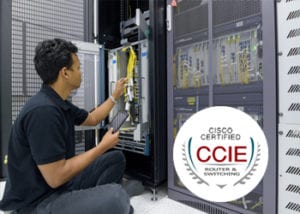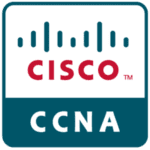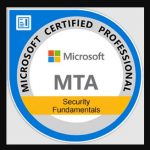CCIE Routing & Switching course in Dubai
CCIE Routing & Switching course in Dubai
Overview of the course
CCIE course is intended for individuals just beginning their pursuit of the CCIE certification CCIE Routing & Switching certification. The Cisco Certified Internetwork Expert (CCIE) certification is accepted worldwide as the most prestigious networking certification in the industry. Network Engineers holding an active Cisco CCIE certification are recognized for their expert network engineering skills and mastery of Cisco products and solutions. The CCIE community has established a reputation for leading the networking industry in deep technical networking knowledge and is deployed into the most technically challenging network assignments.
Program quality, relevance, and value
The program continually updates and revises its testing tools and methodologies to ensure unparalleled program quality, relevance and value. The CCIE program sets the standard for internet working expertise through a rigorous written exam and a performance-based lab.
Cisco introduced the CCIE certification in 1993 to assist the industry in distinguishing the top echelon of internetworking experts worldwide. Today, CCIE certification holders represent less than 3% of all certified Cisco professionals and less than 1% of the networking professionals worldwide.

The learning outcome of CCIE Routing and Switching course:
This CCIE Routing and Switching course imparts detailed knowledge of Computer Networks, various protocols used in Communication, Managing and configuring Cisco Switches and Routers, and various WAN technologies. After completing the CCIE Routing and Switching course, the student can manage Network for an Organization.
Zabeel Institute is the best training institute in Dubai for CCIE Routing and Switching Courses.
Who needs CCIE Routing and Switching course?
IT professionals with at least a year of professional networking experience and a high school diploma or equivalent. Students are trained to install, maintain and troubleshoot both LAN and WAN for systems with anywhere from 100 to over 500 nodes. They also gain expertise in various network protocols and features, including AppleTalk, Route Redistribution, Ethernet, and Access Lists.
We are one of the Top ranking training institutes in Dubai
We will keep you updated on the course content and stay updated on CISCO Certification course contents. To know more about CCIR R&S, click here
CCIE Routing and Switching Course Detailed Content:
- 2.1 LAN switching technologies
- 2.1.a Implement and troubleshoot switch administration
- 2.1.a (i) Managing MAC address table
- 2.1.a (ii) errdisable recovery
- 2.1.a (iii) L2 MTU
- 2.1.b Implement and troubleshoot layer 2 protocols
- 2.1.b (i) CDP, LLDP
- 2.1.b (ii) UDLD
- 2.1.c Implement and troubleshoot VLAN
- 2.1.c (i) Access ports
- 2.1.c (ii) VLAN database
- 2.1.c (iii) Normal, extended VLAN, voice VLAN
- 2.1.d Implement and troubleshoot trunking
- 2.1.d (i) VTPv1, VTPv2, VTPv3, VTP pruning
- 2.1.d (ii) dot1Q
- 2.1.d (iii) Native VLAN
- 2.1.d (iv) Manual pruning
- 2.1.e Implement and troubleshoot EtherChannel
- 2.1.e (i) LACP, PAgP, manual
- 2.1.e (ii) Layer 2, layer 3
- 2.1.e (iii) Load‐balancing
- 2.1.e (iv) Etherchannel misconfiguration guard
- 2.1.f Implement and troubleshoot spanning‐tree
- 2.1.f (i) PVST+/RPVST+/MST
- 2.1.f (ii) Switch priority, port priority, path cost, STP timers
- 2.1.f (iii) port fast, BPDUguard, BPDUfilter
- 2.1.f (iv) loopguard, rootguard
- 2.1.g Implement and troubleshoot other LAN switching technologies
- 2.1.g (i) SPAN, RS2PAN, ERSPAN
- 2.1.h Describe chassis virtualization and aggregation technologies
- 2.1.h (i) Multichassis
- 2.1.h (ii) VSS concepts
- 2.1.h (iii) Alternative to STP
- 2.1.h (iv) StackWise
- 2.1.h (v) Excluding specific platform implementation
- 2.1.i Describe spanning‐tree concepts
- 2.1.i (i) Compatibility between MST and RSTP
- 2.1.i (ii) STP dispute, STP bridge assurance
- 2.2 Layer 2 multicast
- 2.2.a Implement and troubleshoot IGMP
- 2.2.a (i) IGMPv1, IGMPv2, IGMPv3
- 2.2.a (ii) IGMP snooping
- 2.2.a (iii) IGMP querier
- 2.2.a (iv) IGMP filter
- 2.2.a (v) IGMP proxy
- 2.2.b Explain MLD
- 2.2.c Explain PIM snooping
- 2.2.a Implement and troubleshoot IGMP
- 2.3 Layer 2 WAN circuit technologies
- 2.3.a Implement and troubleshoot HDLC
- 2.3.b Implement and troubleshoot PPP
- 2.3.b (i) Authentication (PAP, CHAP)
- 2.3.b (ii) PPPoE
- 2.3.b (iii) MLPPP
- 2.3.c Describe WAN rate‐based ethernet circuits
- 2.3.c (i) Metro and WAN Ethernet topologies
- 2.1.a Implement and troubleshoot switch administration
- 2.3.c (ii) Use of rate‐limited WAN ethernet services
37% 3.0 Layer 3 Technologies
- 3.1 Addressing technologies
- 3.1.a Identify, implement and troubleshoot IPv4 addressing and subnetting
- 3.1.a (i) Address types, VLSM
- 3.1.a (ii) ARP
- 3.1.b Identify, implement and troubleshoot IPv6 addressing and subnetting
- 3.1.b (i) Unicast, multicast
- 3.1.b (ii) EUI‐64
- 3.1.b (iii) ND, RS/RA
- 3.1.b (iv) Autoconfig/SLAAC, temporary addresses (RFC4941)
- 3.1.b (v) Global prefix configuration feature
- 3.1.b (vi) DHCP protocol operations
- 3.1.b (vii) SLAAC/DHCPv6 interaction
- 3.1.b (viii) Stateful, stateless DHCPv6
- 3.1.b (ix) DHCPv6 prefix delegation
- 3.1.a Identify, implement and troubleshoot IPv4 addressing and subnetting
- 3.2 Layer 3 multicast
- 3.2.a Troubleshoot reverse path forwarding
- 3.2.a (i) RPF failure
- 3.2.a (ii) RPF failure with the tunnel interface
- 3.2.b Implement and troubleshoot IPv4 protocol independent multicast
- 3.2.b (i) PIM dense mode, sparse mode, sparse‐dense mode
- 3.2.b (ii) Static RP, auto‐RP, BSR
- 3.2.b (iii) BiDirectional PIM
- 3.2.b (iv) Source‐specific multicast
- 3.2.b (v) Group to RP mapping
- 3.2.b (vi) Multicast boundary
- 3.2.c Implement and troubleshoot multicast source discovery protocol
- 3.2.c (i) Intra‐domain MSDP (anycast RP)
- 3.2.c (ii) SA filter
- 3.2.d Describe IPv6 multicast
- 3.2.d (i) IPv6 multicast addresses
- 3.2.d (ii) PIMv6
- 3.3 Fundamental routing concepts
- 3.3.a Implement and troubleshoot static routing
- 3.3.b Implement and troubleshoot default routing
- 3.3.c Compare routing protocol types
- 3.3.c (i) Distance vector
- 3.3.c (ii) Link state
- 3.3.c (iii) Path vector
- 3.3.d Implement, optimize and troubleshoot administrative distance
- 3.3.e Implement and troubleshoot passive interface
- 3.3.f Implement and troubleshoot VRF lite
- 3.3.g Implement, optimize and troubleshoot filtering with any routing protocol
- 3.3.h Implement, optimize and troubleshoot redistribution between any routing protocol
- 3.3.i Implement, optimize and troubleshoot manual and auto summarization with any routing protocol
- 3.3.j Implement, optimize and troubleshoot policy‐based routing
- 3.3.k Identify and troubleshoot sub‐optimal routing
- 3.3.l Implement and troubleshoot bidirectional forwarding detection
- 3.3.m Implement and troubleshoot loop prevention mechanisms
- 3.3.m (i) Route tagging, filtering
- 3.3.m (ii) Split horizon
- 3.3.m (iii) Route poisoning
- 3.3.n Implement and troubleshoot routing protocol authentication
- 3.4 RIP (v2 and v6)
- 3.4.a Implement and troubleshoot RIPv2
- 3.4.b Describe RIPv6 (RIPng)
- 3.5 EIGRP (for IPv4 and IPv6)
- 3.5.a Describe packet types
- 3.5.a (i) Packet types (hello, query, update, and such)
- 3.5.a (ii) Route types (internal, external)
- 3.5.b Implement and troubleshoot neighbor relationship
- 3.5.b (i) Multicast, unicast EIGRP peering
- 3.5.b (ii) OTP point‐to‐point peering
- 3.5.b (iii) OTP route‐reflector peering
- 3.5.b (iv) OTP multiple service providers scenario
- 3.5.c Implement and troubleshoot loop free path selection
- 3.5.c (i) RD, FD, FC, successor, feasible successor
- 3.5.c (ii) Classic metric
- 3.5.c (iii) Wide metric
- 3.5.d Implement and troubleshoot operations
- 3.5.d (i) General operations
- 3.5.d (ii) Topology table, update, query, active, passive
- 3.5.d (iii) Stuck in active
- 3.5.d (iv) Graceful shutdown
- 3.5.e Implement and troubleshoot EIGRP stub
- 3.5.e (i) Stub
- 3.5.e(ii) Leak‐map
- 3.5.f Implement and troubleshoot load‐balancing
- 3.5.f (i) equal‐cost
- 3.5.f (ii) unequal‐cost
- 3.5.f (iii) add‐path
- 3.5.g Implement EIGRP (multi‐address) named mode
- 3.5.g (i) Types of families
- 3.5.g (ii) IPv4 address‐family
- 3.5.g (iii) IPv6 address‐family
- 3.5.h Implement, troubleshoot and optimize EIGRP convergence and scalability
- 3.5.h (i) Describe fast convergence requirements
- 3.5.h (ii) Control query boundaries
- 3.5.h (iii) IP FRR/fast reroute (single hop)
- 3.5.h (iv) Summary leak‐map
- 3.5.h (v) Summary metric
- 3.7 BGP
- 3.7.a Describe, implement and troubleshoot peer relationships
- 3.7.a (i) Peer‐group, template
- 3.7.a (ii) Active, passive
- 3.7.a (iii) States, timers
- 3.7.a (iv) Dynamic neighbors
- 3.7.b Implement and troubleshoot IBGP and EBGP
- 3.7.b (i) EBGP, IBGP
- 3.7.b (ii) 4 bytes AS number
- 3.7.b (iii) Private AS
- 3.7.c Explain attributes and best‐path selection
- 3.7.d Implement, optimize and troubleshoot routing policies
- 3.7.d (i) Attribute manipulation
- 3.7.d (ii) Conditional advertisement
- 3.7.d (iii) Outbound route filtering
- 3.7.d (iv) Communities, extended communities
- 3.7.d (v) Multi‐homing
- 3.7.e Implement and troubleshoot scalability
- 3.7.e (i) Route‐reflector, cluster
- 3.7.e (ii) Confederations
- 3.7.f Implement and troubleshoot multiproctocol BGP
- 3.7.f (i) IPv4, IPv6, VPN address‐family
- 3.7.g Implement and troubleshoot AS path manipulations
- 3.7.g (ii) Prepend
- 3.7.e (ii) Confederations
- 3.7.g (iii) Regexp
- 3.7.h Implement and troubleshoot other features
- 3.7.h (i) Multipath
- 3.7.h (ii) BGP synchronization
- 3.7.h (iii) Soft reconfiguration, route refresh
- 3.7.i Describe BGP fast convergence features
- 3.7.i (i) Prefix independent convergence
- 3.7.i (ii) Add‐path
- 3.7.i (iii) Next‐hop address tracking
- 3.7.a Describe, implement and troubleshoot peer relationships
- 3.8 ISIS (for IPv4 and IPv6)
- 3.8.a Describe basic ISIS network
- 3.8.a (i) Single area, single topology
- 3.8.b Describe neighbor relationship
- 3.8.c Describe network types, levels and router types
- 3.8.c (i) NSAP addressing
- 3.c.c (ii) Point‐to‐point, broadcast
- 3.8.d Describe operations
- 3.8.e Describe optimization features
- 3.8.e (i) Metrics, wide metric
- 3.8.a Describe basic ISIS network
- 3.2.a Troubleshoot reverse path forwarding
We are fully accredited Institute by KHDA and endorsed by students as the best CCIE Routing and Switching training institute in Dubai.
To know more about other courses in IT Academy, click here.
Apply Now



